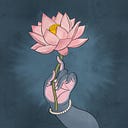Konarka: Sthala Purāṇa
The Jagamohan or Audience Hall of the Temple to Sūrya at Konark has come to be more specifically known as the “Black Pagoda.” This has probably come about through some association of the epithet kāla, meaning “black,” which the Hindoos apply to all deserted or desecrated religious edifices. The term is certainly not derived from the general color of the building, for the stone of which it is built is light sandy brown in color. The name Konark or Konarka comes from the vernacularised forms of the two Sanskrit words, kona, corner and arka, the sun, implying the corner of the sun, ie., ‘the corner of the world dedicated to the sun’. It is thus to be surmised that this locality had for ages been associated in men’s minds as especially blessed by the sun, and that long before this temple was built, Konark had been a prominent center of Sun-worship. This probability is also supported by the legend of the founding of the temple.
This legend, which is quite characteristic of the great imagination and picturesqueness of the Hindoo mind, is, according to the Samba Purana, as follows.
Samba (one of the heroes of the Mahabharata), the son of Krishna by Jambavati, is enjoying life in the heavenly home of his father. A handsome young man, full of spirit and given to the display of it, he has become the object of the displeasure of the sage, Narada, who believes him lacking in the respect due a learned man.
So that, in spite, Narada maligns Samba to Krishna, insinuating that for a son, Samba is over-familiar with his step-mothers, the 1,600 present wives of the god. Krishna, quite proof against this, disbelieves it. Narada does, however, soon after find the opportunity to his revenge. One fine, warm day the wives are all naked bathing in a great tub, and, moreover, flushed with wine, they are rather unrestrained in their dousing each other with water. The sage lures Samba to the scene; then, contriving the presence of Krishna, accuses Samba with his pernicious beauty of having too exciting an influence on the wives. Krishna, presented with the evidence of this spectacle, in an instant anger curses his son with the curse of leprosy. Although Samba later proves his complete innocence the curse cannot be revoked and the leprosy takes hold.
Krishna then does the best he can for his unfortunate boy: instructs him how he can be cured. Samba is to go to Earth, and by the river that runs through Konarak, he is to lead the life of an ascetic and put himself upon the mercy of the one god, Sūrya, who can effect his cure. For twelve years Samba prosecutes his devotion to the Sun-god. In a vision Sūrya then appears to him in all his glory. Samba has learned the twenty-one laudatory epithets of the ray-garlanded One. He repeats them without fault.
The god answers his prayer, and makes him whole. The next day, Samba, bathing with more than usual joy in the river, finds a marvellous image of the god to whom he is so much indebted. Of course, how the image came to be at the bottom of the river was another point that had to be explained. That went back to ages before that age, to the time when Sūrya was married to Sanjna, a daughter of the metal-worker Visvakarma. But so fierce and rough had the god seemed to her that in disgust she would not suffer his embraces. In dismay at this repulse Sūrya consulted Brahma, and on that divinity’s advice went to the father of the girl, who evidently knew his daughter’s likes and dislikes, to get himself made over more to the form she had been taught to appreciate. Visvakarma placed Surya on his lathe, and worked over all of the god except the feet. He pared off a full eighth of the body, and then smoothed him down properly, according to the traditions of the family. Unwilling to scrap the divine refuse, Visvakarma fashioned out of it the discus of Vishnu, the trident of Siva, the club of Kubera, the lance of Kartikeya. Of the great amount he still had left he made a likeness of Surya himself. Thus came the image that Samba recovered from the bed of the river and about which in gratitude he built a sanctuary. And thus was the beginning of the great temple at Konark.
Excerpt from: The Kama Sutra of Vatsyayana translated by Richard Francis Burton
__________________________________________
If you find value in my work, I hope you consider becoming a patron or making a contribution to hindu.aesthetic@okicici. Hindu Aesthetic requires a lot of time and effort and your support would mean that I can continue bringing you the best possible content. ❤
